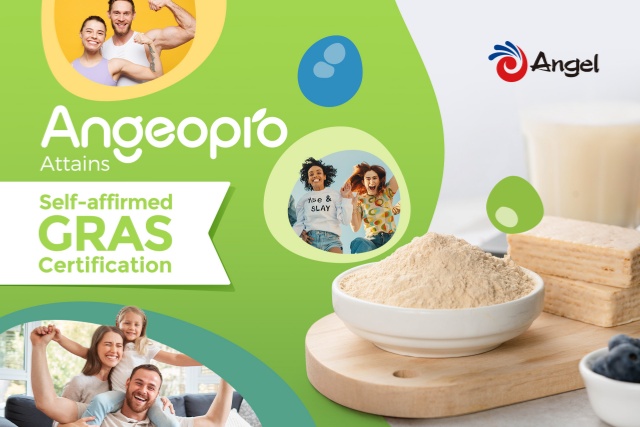-
Home > News & Events > News > Ye-savory
By Elizabeth Green
Today’s consumers increasingly seek top-quality ingredients while purchasing food and beverages that reflect their nutritional and environmental values. With this, consumers are paying closer attention to product labels and are showing interest in recognizable ingredients they deem familiar, higher quality and “closer-to-nature.”

FoodIngredientsFirst takes a deep dive into the hydrocolloid space, which is crucial to delivering mouthfeel, preserving structure and viscosity, as well as increasing the stability and thickness of foods and beverages.
“Hydrocolloids and other stabilizers and emulsifiers must be listed on ingredient labels and may also support clean label targets,” says Zach Gall, global senior marketing manager, wholesome ingredients and texturants, ADM.
Answering market demands
According to ADM’s Outside Voice research, a significant number of consumers recognize hydrocolloids on product labels, with 44% of US consumers showing familiarity with specifically named hydrocolloids.
“By using ingredients derived from natural sources as texturants, such as hydrocolloids, stabilizers, gums and emulsifiers, brands will be well-positioned to capture shoppers’ attention as they scrutinize product labels,” explains Gall.
According to Innova Market Insights data, after experiencing several years in the spotlight, more is expected from plant-based innovation, naturally, as consumers demand tougher clean label credentials and improved taste and texture.
Charlotte Wallart, food product manager at Nexira, says, “we have been able to create ingredients that reach taste and texture customers’ expectations.”
Nexira offers various specialties, including acacia-based solutions, Naltive locust bean gum, Naltive tara gum and Naltive guar gum. “All our Naltive range is perfectly suitable for plant-based products and answers to the growing expectations of our customers: taste, technicity and quality.”
According to new trends, there’s still a lot to come, for example, with new blends to create new synergies between different hydrocolloids to answer new market needs, she underscores.
Enhanced textures needed for plant-based dairy
According to ADM, this interest in quality ingredients and clean labels is further translated to the dairy aisle when consumers actively seek plant-based alternatives to traditional offerings.
“Consumers shifting to alternative dairy options still expect a sensory experience equivalent to the creaminess and richness of traditional products. By incorporating hydrocolloids and emulsifiers in dairy alternatives, brands can solve potential sensory challenges to mimic the gold standard of the traditional offerings,” notes Gall.
For instance, hydrocolloids help ingredients remain within an emulsion to retain the desired physical attributes in a final product. “Hydrocolloids are often found in low-fat foods, including ice cream and dairy products,” he comments.
For ADM, one of the most significant obstacles in the alternative dairy space is mimicking the texture, taste and sensorial attributes that consumers associate with traditional applications such as yogurts, ice cream, and other dairy products.
As a nutritious protein snack option, the yogurt and yogurt alternatives category has grown exponentially to give consumers plenty of choices to fit their lifestyles – from dairy to plant-based, short shelf life to long shelf life, and spoonable to drinkable, underscores Neil Morrison, head of global sales technical service at CP Kelco.
CP Kelco has launched a range of solutions to support the growing list of plant protein bases available and help solve formulators’ toughest challenges.
“We recently partnered with Chr. Hansen to develop nature-based stabilizers that complement their cultures for plant-based, ambient yogurt alternatives or ‘vegurts,’ including a drinking vegurt and a spoonable vegurt with the added sustainability benefit of long shelf life,” explains Morrison.
Meanwhile, Wallart at Nexira says the company’s Naltive range provides customers with ingredients for plant-based alternatives, such as plant-based milk, ice cream or frozen yogurt. “Our ingredients help to improve the texture and the mouthfeel in finished products without animal proteins, less fat.”
Colloidal characteristics
Different hydrocolloids show different characteristics due to their different structure and composition.
According to Chris Guo, director of the Protein Nutrition and Flavoring Technology Center at Angel Yeast, these characteristics also determine their application fields, methods and bring diversity to hydrocolloids.
“Taking Konjac gum as an example, konjac gum, because of its huge molecular weight, thus showing a very high viscosity, is currently the highest viscosity of the natural colloid hydrophilic colloid, due to the viscosity is too large, in the use of the process will bring us great inconvenience, such as poor fluidity, eating palatability and so on.”
“In response to this problem, we generally reduce or modify the viscosity of konjac gum according to the different application fields of konjac gum to ensure that it can be applied to food or other fields and bring a good experience to consumers,” he explains.
Plant-based meat alternatives
Angel Yeast has also established a development platform for plant-based meat products, providing a full set of application solutions for downstream plant-based meat customers.
One such example is the development of its Angeopro series, which uses yeast protein to improve the nutritional balance of plant-based meat, and the development of the Angeoboost series of yeast extract to enhance the taste of plant-based meat.
“Also, through heat reaction technology, Angearom series products featuring meaty flavor are developed to compensate for the loss of meaty notes of plant-based meat,” outlines Guo.
“Now, we can use konjac gum products to improve the texture of plant-based meat, such as tenderness and chewability.”
In addition, he says konjac gum, like yeast extract, has natural food properties, so its application in plant-based meat is easier to recognize.
Animal vs. plant-based
ADM is also working on hydrocolloid solutions for meat alternatives that help with the textural and binding challenges customers face in this segment.
Consumers still use animal-based products as a reference point for taste and texture in plant-based protein, adds Morrison at CP Kelco.
“The growth of plant-based products will depend on stabilizers and gelling agents to improve texture and functionality and provide an eating experience that resembles meat and dairy more closely. Thinking one step ahead of trends, we envision the future of ingredient innovation to be based on several important concepts: creating products that are both “good for me” and good for the planet; considerate of cultures with more vegan, halal and kosher availability; appealing to the senses, especially texture, sight and mouthfeel; and always with an abundance of choices to support affordability and supply integrity.”
As the market evolves and consumer preferences change, so does the need for hydrocolloids, he asserts.
Securing supply of ingredients
Consumers still want to eat foods they believe are “good for you” and good for the planet, but they can’t always afford premium products, flags Morrison.
“Inflationary pressures, starch shortages and a logistics imbalance have created challenges that have affected R&D priorities and product availability. Prioritizing these issues can be a difficult equation for manufacturers to solve. From the consumers’ point of view, we know that clean label transparency and sustainability are still important topics, but price has become a top concern this year,” he explains.
“A lot goes into the product developer’s decision about hydrocolloids. Last year brought the added burden of supply disruptions to further complicate the decision.”
Food manufacturers’ hydrocolloid choice will depend on the functionality desired for a recipe, whether you want gelling, suspension, emulsion stability, viscosity, mouthfeel, or even multiple functions, as a long ingredient list can be seen as undesirable by consumers.
“Process parameters should also be considered, such as temperature, pH, shelf life, and order of addition,” concludes Morrison. “Further, in order to obtain the full functionality from a hydrocolloid, care must be taken regarding dispersion and dissolution.”
Source: Foodingredients1st
This exclusive interview was published in Foodingredients1st.
Link to the following landing page: https://www.foodingredientsfirst.com/news/honing-in-on-hydrocolloids-familiar-plant-based-ingredients-capture-consumer-attention-supply-issues-spotlighted.html




